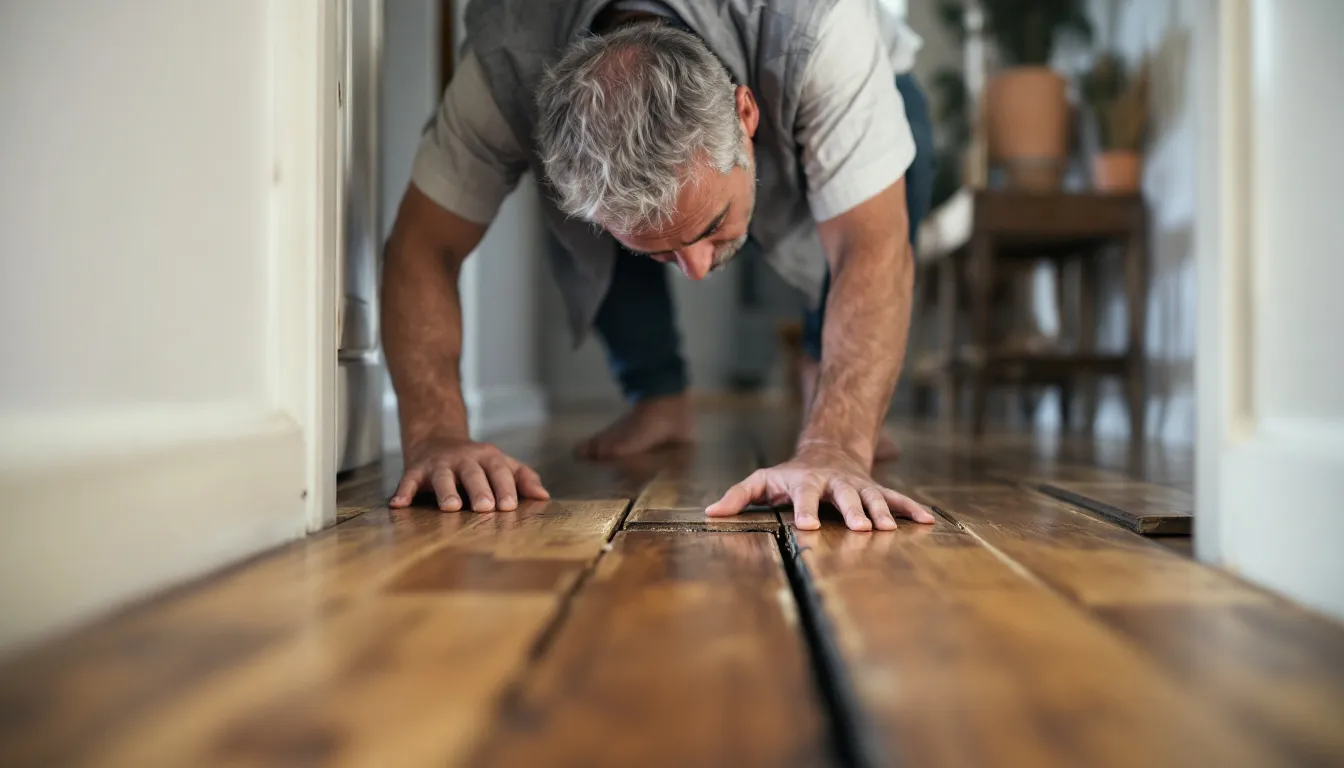
Ever stepped on a floorboard and heard that annoying creak? You’re not alone. Fixing a creaky floorboard is a task you can tackle without calling in the pros. About 37% of homeowners prefer to handle such projects themselves. Why? Because it’s satisfying, saves money, and gives you a sense of accomplishment.
With just a few basic tools, you can silence those squeaks and enjoy a quieter home. This guide will walk you through fixing a creaky floorboard, making it as simple as possible. So, grab your tools, and let’s kickstart this DIY project together!
What You Need
Before you dive into fixing that creaky floorboard, gather the right tools. Having the essentials on hand makes the job smoother and more efficient. Let’s break down what you’ll need.
Essential Tools
-
Hammer
A hammer is your go-to tool for driving nails into the floorboard. It helps secure loose boards and eliminate those pesky squeaks. Make sure you have a sturdy one with a comfortable grip. -
Nails or Screws
Depending on your floor type, you might need nails or screws. Nails are great for quick fixes, while screws offer a more secure hold. Choose the right size to avoid damaging the board. -
Drill
A drill is essential if you’re using screws. It creates precise holes, ensuring the screws fit snugly. This tool speeds up the process and provides a professional finish. -
Wood Glue
Wood glue adds extra stability to your repair. It’s perfect for securing loose boards without visible fasteners. Apply it carefully to avoid excess glue on the surface.
Optional Tools
-
Floorboard Lubricant
Sometimes, a little lubrication can silence a creak. Floorboard lubricants reduce friction between boards, offering a temporary fix. They’re easy to apply and can be a quick solution. -
Shim
Shims are small wedges that fill gaps under floorboards. They provide support and prevent movement, which can cause creaks. Use them when you notice unevenness in the floor. -
Screwdriver
If you prefer manual tools, a screwdriver is handy for tightening screws. It’s also useful for minor adjustments and offers more control than a drill.
Having these tools ready sets you up for success. It will not matter even if you’re a seasoned DIY enthusiast or a first-timer, these essentials and optional tools will help you tackle the task with confidence.
Who Should Try This?
DIY Enthusiasts
If you love rolling up your sleeves and diving into home projects, fixing a creaky floorboard is right up your alley. You get to use your hands, solve a problem, and enjoy the satisfaction of a job well done.
Plus, it’s a great way to add another skill to your DIY toolkit. You don’t need to be a professional carpenter to tackle this task. With the right tools and a bit of patience, you can silence those squeaks and make your home more comfortable.

Homeowners with Basic Tool Knowledge
You don’t have to be a DIY expert to fix a creaky floorboard. If you know your way around a hammer and drill, you’re already halfway there. This project is perfect for homeowners who want to maintain their property and save money on repairs.
You’ll learn how to identify the source of the creak and apply simple solutions to fix it. It’s a practical skill that can come in handy for other home maintenance tasks.
Renters with Permission to Make Repairs
As a renter, you might think you’re stuck with creaky floors. But if you have permission from your landlord, you can take matters into your own hands. Fixing a creaky floorboard can improve your living space and make it more enjoyable.
Just make sure to check your lease agreement or talk to your landlord before starting any repairs. With their approval, you can use basic tools to address the issue and enjoy a quieter home.
Step-by-Step Detailed Instructions
Identifying the Source of the Creak
Before you can fix a creaky floorboard, you need to pinpoint where the noise is coming from. Here’s how you can do it:
Walk and Listen
Start by walking slowly across the floor. Pay close attention to the sounds beneath your feet. Listen for the telltale creak that signals a loose board. You might need to walk back and forth a few times to accurately locate the source.
Mark the Spot
Once you’ve identified the creaky area, mark it with a piece of chalk or a sticky note. This will help you remember the exact location when you’re ready to fix it. Marking the spot ensures you don’t waste time searching for the creak again.
Fixing the Creak
Now that you’ve found the source, it’s time to fix a creaky floorboard. Choose the method that best suits your situation.
Method 1: Nailing Down Loose Boards
-
Position the Nail: Place a nail at a slight angle near the edge of the creaky board.
-
Hammer It In: Gently tap the nail into the board until it’s flush with the surface. This secures the board and reduces movement.
-
Check for Creaks: Walk over the area again to ensure the creak is gone.
Method 2: Using Screws for a Secure Fix
-
Drill a Pilot Hole: Use a drill to create a small hole in the board. This prevents the wood from splitting.
-
Insert the Screw: Drive a screw into the pilot hole. Make sure it’s tight but not over-tightened.
-
Test the Floor: Step on the board to confirm the creak has been eliminated.
Method 3: Applying Wood Glue for Stability
-
Lift the Board Slightly: Use a pry bar to gently lift the board enough to apply glue.
-
Apply Wood Glue: Squeeze a small amount of wood glue into the gap.
-
Press the Board Down: Push the board back into place and hold it for a few minutes.
-
Let It Dry: Allow the glue to dry completely before walking on the board.
Method 4: Using Shims for Support
-
Locate the Gap: Find the gap between the floorboard and the joist.
-
Insert a Shim: Slide a shim into the gap to provide support.
-
Trim the Shim: Cut off any excess shim sticking out from the board.
-
Secure the Shim: Tap it gently with a hammer to ensure it’s snug.
Each method offers a practical way to fix a creaky floorboard. Choose the one that fits your needs and tools. With these steps, you can confidently address the issue and enjoy a peaceful home environment.
Potential Challenges
When you set out to fix a creaky floorboard, you might encounter a few hurdles. Don’t worry, though. With some preparation and patience, you can overcome these challenges and achieve a smooth repair.
Accessing the Floorboard
Accessing the floorboard can sometimes be tricky. You might find that furniture or carpets block your way. Start by clearing the area. Move any furniture or rugs that cover the creaky spot. This gives you a clear workspace and prevents accidental damage to your belongings.
If your floorboards are under a carpet, you may need to carefully lift the carpet to reach the boards. Use a carpet knife to cut along the edges if necessary. Remember to handle the carpet gently to avoid tearing it. Once you have access, you can proceed with your repair.
Matching Floorboard Materials
Matching the materials of your floorboards can be another challenge. Different types of wood require different approaches. For example, hardwood floors might need specific nails or screws to avoid splitting. Softwood floors, on the other hand, might require a gentler touch.
Here’s a quick comparison of wood types and their repair needs:
|
Wood Type |
Repair Needs |
Tools Required |
|---|---|---|
|
Hardwood |
Specific nails/screws |
Hammer, Drill |
|
Softwood |
Gentle handling |
Wood Glue, Shims |
|
Laminate |
Avoid moisture |
Floorboard Lubricant |
|
Engineered |
Check for veneer thickness |
Screwdriver, Shims |
Understanding your floor’s material helps you choose the right tools and methods. If you’re unsure, consult a professional to avoid mismatches that could lead to further damage.
Avoiding Damage to Surrounding Boards
When fixing a creaky floorboard, you want to avoid damaging the surrounding boards. This requires precision and care. Use a gentle hand when hammering nails or driving screws. Ensure that your tools are in good condition to prevent slipping or over-tightening.
If you’re using shims, insert them carefully to avoid lifting adjacent boards. A small tap with a hammer should suffice to secure them without causing additional creaks.
Always test the area after each step to ensure that the repair hasn’t affected nearby boards. By keeping these potential challenges in mind, you can approach your floorboard repair with confidence. Each step you take brings you closer to a quieter, more comfortable home.
Common Mistakes to Avoid
When you’re fixing a creaky floorboard, it’s easy to make a few common mistakes. These can lead to more problems down the road. Let’s look at some pitfalls you should avoid to ensure a successful repair.
Using Incorrect Tools
Using the wrong tools can complicate your repair efforts. You might think any nail or screw will do, but that’s not the case. Each type of floorboard requires specific tools for the best results.
For instance, hardwood floors need particular nails or screws to prevent splitting. Softwood floors might need a gentler approach with wood glue or shims. Choosing the right tools ensures a smooth repair and prevents further damage.
Over-tightening Screws
Over-tightening screws is a mistake many people make. It seems like a good idea to secure the board tightly, but it can cause more harm than good.
When you over-tighten, you risk splitting the wood or damaging the floorboard. This can lead to more creaks or even structural issues. Instead, tighten screws just enough to hold the board in place without forcing them. This approach maintains the integrity of your floor.
Ignoring Underlying Structural Issues
Ignoring underlying structural issues is a big no-no. You might fix the creak temporarily, but if there’s a deeper problem, it will resurface. Before you start, examine the subfloor for any signs of damage or moisture. A concrete subfloor without a vapor retarder can absorb too much moisture, leading to premature wear.
Addressing these issues first ensures a long-lasting fix and prevents future problems.
Neglecting to adequately prepare the subfloor can result in premature wear or even complete failure of the new flooring. It’s vital to thoroughly examine and prepare the subfloor before proceeding with installation to avoid such consequences.
By avoiding these common mistakes, you can confidently tackle your creaky floorboard repair. You’ll enjoy a quieter home and extend the life of your flooring.
Common Concerns
When you’re about to fix a creaky floorboard, you might have a few questions on your mind. Let’s address some common concerns to help you feel more confident about tackling this project.
Will This Damage My Floor?
You might worry about causing damage while fixing your floorboard. Rest assured, using the right tools and techniques minimizes the risk. Choose nails or screws that match your floor type. Avoid over-tightening screws to prevent splitting the wood. If you’re unsure about your floor’s material, consult a professional.
An NWFA Certified Inspector can provide guidance on the best approach for your specific flooring.
How Long Will the Fix Last?
The longevity of your repair depends on the method you choose and the condition of your floor. A well-executed fix can last for years. Using screws often provides a more durable solution than nails. Wood glue offers stability but may require reapplication over time.
Regular maintenance, like checking for loose boards, helps extend the life of your repair. Keep an eye on your floor’s condition to ensure it remains creak-free.
Is It Safe to Do It Myself?
Safety is a top priority when undertaking any DIY project. Fixing a creaky floorboard is generally safe if you follow proper guidelines. Wear protective gear like gloves and safety glasses. Ensure your workspace is clear of obstacles. If you encounter structural issues, seek professional help.
Structural problems can be serious, so contacting an expert, such as an NWFA Certified Inspector or a structural engineer, is wise. They can assess the situation and recommend the best course of action.
By addressing these concerns, you can approach your floorboard repair with confidence. With the right tools and knowledge, you’ll enjoy a quieter home and the satisfaction of a job well done.
What Else to Know
Tips for Preventing Future Creaks
You’ve tackled the creaky floorboard, but how do you keep those pesky noises at bay? Prevention is key. Here are some handy tips to ensure your floors stay silent:
-
Monitor Moisture Levels: Moisture can wreak havoc on your hardwood floors. It causes them to expand and contract, leading to creaks. Use a hygrometer to keep an eye on humidity levels in your home. Aim for a range between 30% and 50% to maintain optimal conditions.
-
Acclimate New Flooring: If you’re installing new floorboards, let them acclimate to your home’s environment. This reduces the risk of expansion and shrinkage, which can cause creaks. Leave the boards in the room where they’ll be installed for at least 48 hours.
-
Regular Cleaning: Dust and debris can accumulate between floorboards, causing friction and noise. Regularly sweep and vacuum your floors to keep them clean and creak-free.
-
Use Rugs and Mats: Placing rugs or mats in high-traffic areas can reduce wear and tear on your floorboards. They act as a buffer, absorbing impact and preventing movement that leads to creaks.
Regular Maintenance Advice
Keeping your floors in top shape requires a bit of regular maintenance. Here’s how you can extend the life of your floorboards and keep them quiet:
-
Inspect Regularly: Walk around your home and listen for any new creaks. Early detection allows you to address issues before they worsen.
-
Tighten Loose Boards: If you notice any loose boards, tighten them promptly. Use screws or nails to secure them and prevent further movement.
-
Check for Moisture: Look for signs of moisture damage, such as cupping or warping. Address any leaks or spills immediately to prevent long-term damage.
-
Reapply Finish: Over time, the finish on your floorboards can wear down. Reapply a protective finish every few years to keep your floors looking great and protected from moisture.
When to Call a Professional
Sometimes, despite your best efforts, a creaky floorboard might require professional attention. Here’s when you should consider calling in the experts:
-
Persistent Creaks: If you’ve tried multiple methods and the creak persists, it might be time to consult a professional. They can assess the situation and provide a more permanent solution.
-
Structural Issues: If you suspect underlying structural problems, such as a damaged subfloor, seek professional help. Structural issues can compromise the integrity of your home and require expert intervention.
-
Extensive Repairs: For large-scale repairs or installations, a professional can ensure the job is done correctly. They have the tools and expertise to handle complex projects efficiently.
-
Material Matching: If you’re unsure about matching floorboard materials, a professional can guide you. They’ll help you choose the right materials and techniques for a seamless repair.
By following these tips and knowing when to seek help, you can enjoy a creak-free home for years to come. Remember, regular maintenance and monitoring are your best allies in keeping those floorboards silent.
Fixing a creaky floorboard doesn’t have to be a daunting task. With the right tools and guidance, you can tackle this project with confidence. Regular maintenance plays a crucial role in preventing future creaks and prolonging the life of your floor.
Keep an eye on moisture levels and address issues early and you ensure your floors remain in top condition. These simple steps not only help you fix a creaky floorboard but also contribute to a quieter, more comfortable home environment.
Enjoy the feeling of having done a great job and kick back with the calm that follows.


